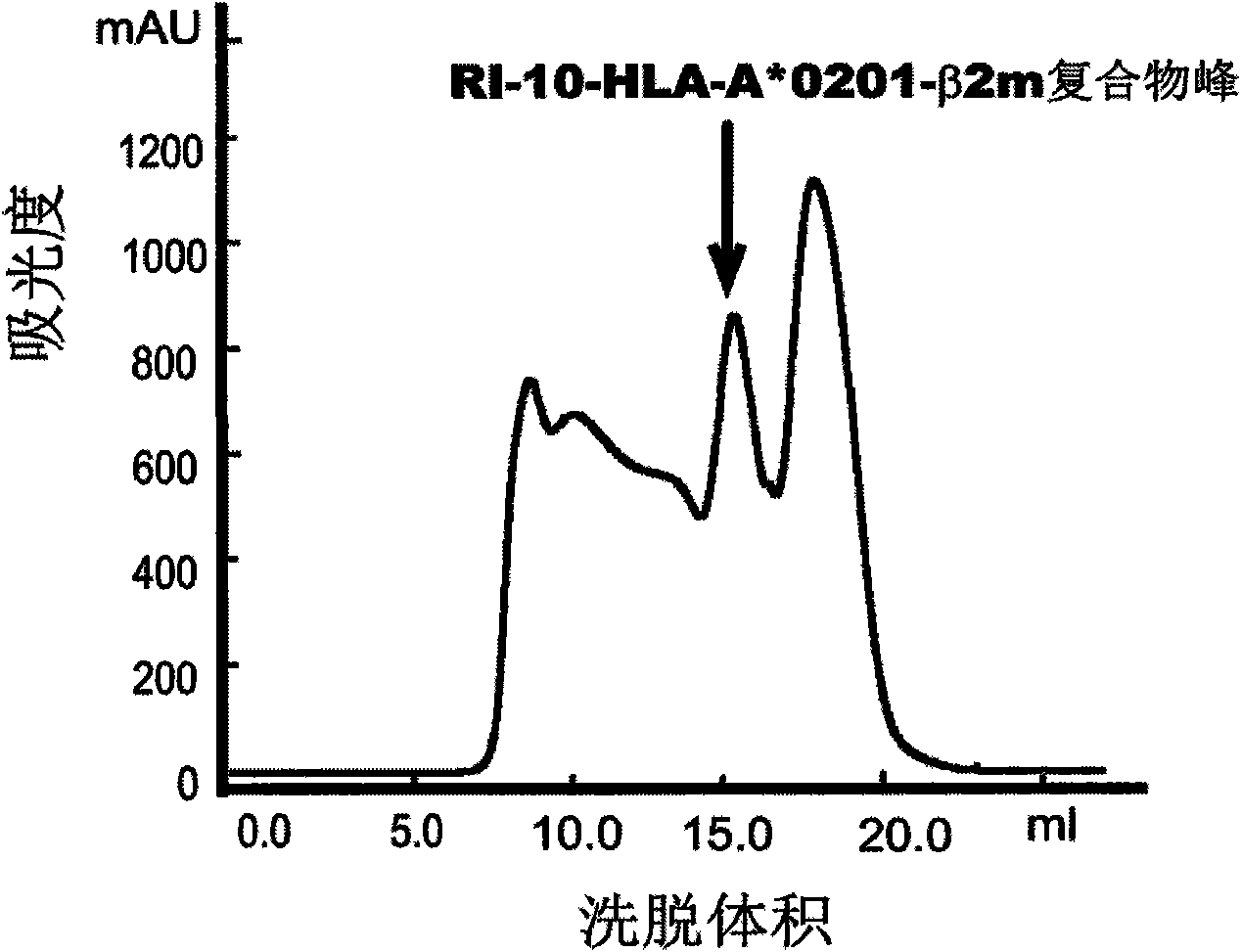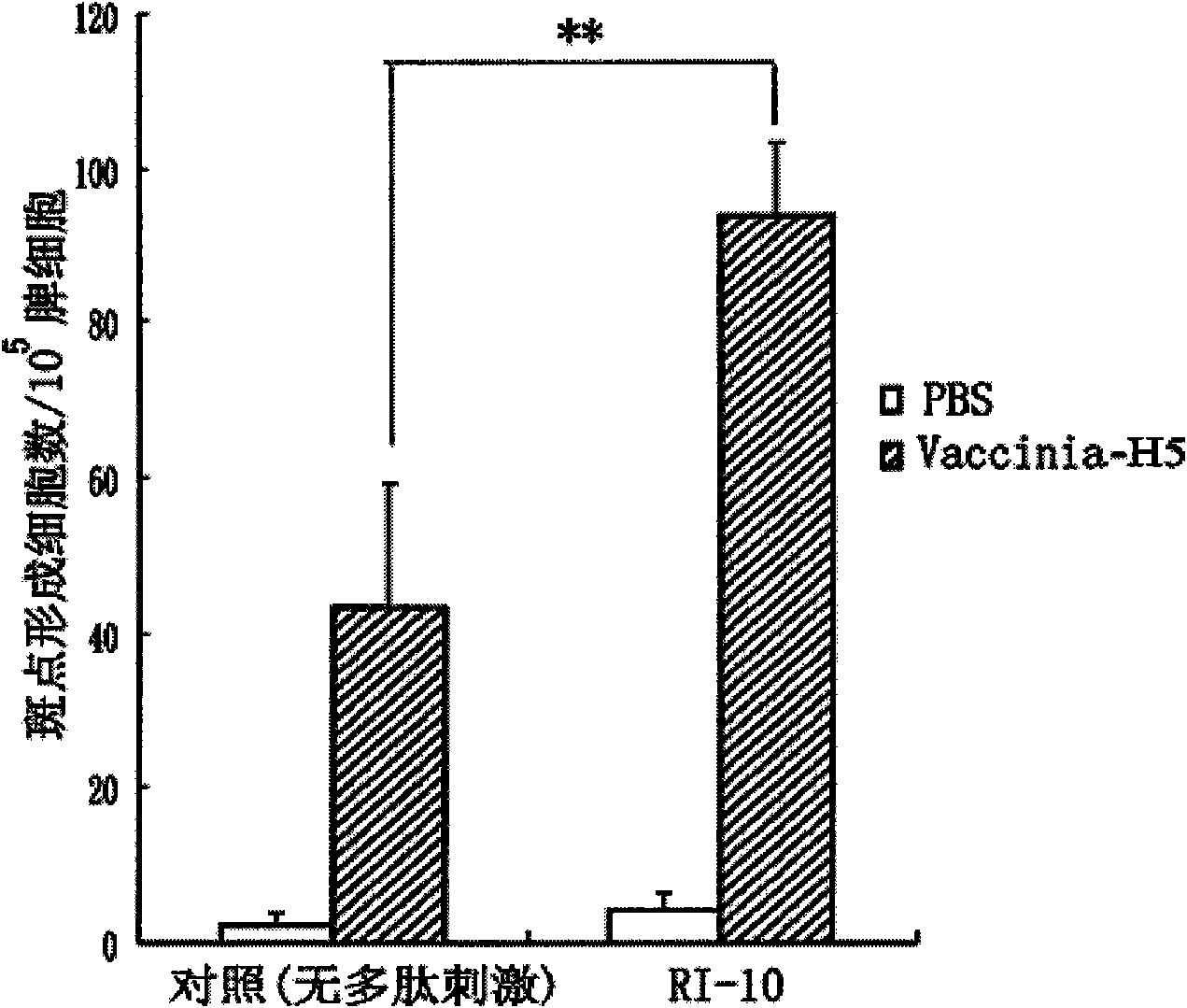CTL epitope polypeptides of bird flu H5N1 virus and applications thereof
An epitope polypeptide, avian influenza technology, applied in the application, antiviral agent, medical preparations containing active ingredients, etc., can solve the problem of no H5N1 virus, H5N1 avian influenza virus T cell detection technology has not been established and other problems
- Summary
- Abstract
- Description
- Claims
- Application Information
AI Technical Summary
Problems solved by technology
Method used
Image
Examples
Embodiment 1
[0051] Example 1. Using refolding experiment to detect the binding ability of polypeptide and HLA-A*0201 molecule
[0052] In the refolding experiment, if the peptide can bind to the HLA-A*0201 molecule, then the peptide, HLA-A*0201 and β2m can form a stable peptide-MHC-β2m ternary complex, and the peptide appears in the molecular sieve chromatogram - Heavy chain-light chain complex peak.
[0053] 1. Preparation of HLA-A*0201 Heavy Chain Extracellular Region Inclusion Body
[0054] 1. Construction of recombinant plasmid I
[0055] The DNA encoding the extracellular region of the heavy chain of HLA-A*0201 (GENBANK ACCESSION NO. AY365426 from the 5' end nucleotides 73-897) was introduced into pET-28(a) to obtain recombinant plasmid I.
[0056] 2. Preparation of HLA-A*0201 Heavy Chain Extracellular Region Inclusion Body
[0057] The monoclonal strain of Escherichia coli BL21 (NEB Company, Cat. No. C2566H) transfected with the recombinant plasmid I was inoculated in a small amo...
Embodiment 2
[0071] Example 2. Using T2 cell binding assay to detect the binding ability of polypeptides to HLA-A2 molecules on the surface of T2 cells
[0072] T2 cells are HLA-A*0201 positive and TAP molecule deficient cell lines. The cells cannot process endogenous antigens, but can present exogenous antigenic peptides. In the absence of antigenic peptides, the expression of HLA-A2 molecules on the cell surface is at a low level. Once a suitable exogenous antigenic peptide binds to HLA-A2 molecules on the surface of T2 cells, the expression of HLA-A2 on the cell surface Strength will be greatly improved.
[0073] 1. Polypeptide RI-10
[0074] T2 cells (ATCC, Cat.No.CRL-1992) were cultured in RPMI-1640 containing 10% fetal bovine serum (FBS, Gibico) (supplemented with 5.9% HEPES, 0.307% glutamic acid, 0.11% sodium pyruvate, 2 % sodium bicarbonate, 50u / ml penicillin, 50u / ml streptomycin), the incubator temperature is 37 ℃, containing 5% CO 2 . Take the cells in the logarithmic growth...
Embodiment 3
[0079] Example 3, ELISPOT analysis was used to detect the polypeptide-induced HLA-A*0201 / K immunized with the pcDNA3.1(+) vector carrying the H5HA gene b Ability of Splenocytes of Transgenic Mice to Produce Specific CTL Responses
[0080] HLA-A*0201 / K b Transgenic mice: purchased from Shanghai Second Military Medical University.
[0081] Preparation of recombinant plasmid III (pcDNA3.1(+) vector inserted into Qinghai Lake H5N1 virus H5HA): design upstream primer (5'-GCTAGCCATGGAGAAAATAGTGCTT-3') and downstream primer (5'-AATGCAAATTCTGCATTGTAAAAGCTT-3') to amplify H5HA Gene (GENBANK ACCESSIONGNO.AAZ16277) was digested with Nhe I and HindIII, and the pcDNA3.1(+) vector (Invitrogen, Catalog nos. V790-20) was digested with Nhe I and HindIII at the same time, and the digested product was placed in After ligation overnight at 18°C, Escherichia coli DH5α (TAKARA, Cat. No. D9057) was transformed. After clone screening and sequencing identification, it was ready for use.
[0082] 1...
PUM
 Login to View More
Login to View More Abstract
Description
Claims
Application Information
 Login to View More
Login to View More - R&D
- Intellectual Property
- Life Sciences
- Materials
- Tech Scout
- Unparalleled Data Quality
- Higher Quality Content
- 60% Fewer Hallucinations
Browse by: Latest US Patents, China's latest patents, Technical Efficacy Thesaurus, Application Domain, Technology Topic, Popular Technical Reports.
© 2025 PatSnap. All rights reserved.Legal|Privacy policy|Modern Slavery Act Transparency Statement|Sitemap|About US| Contact US: help@patsnap.com



